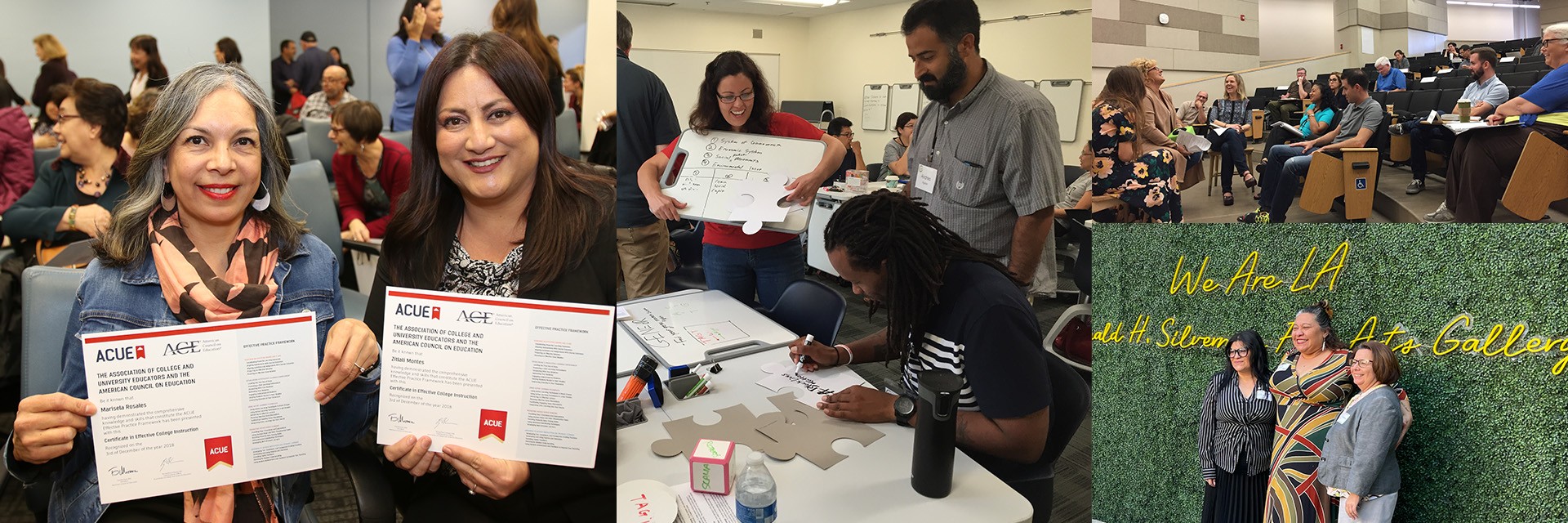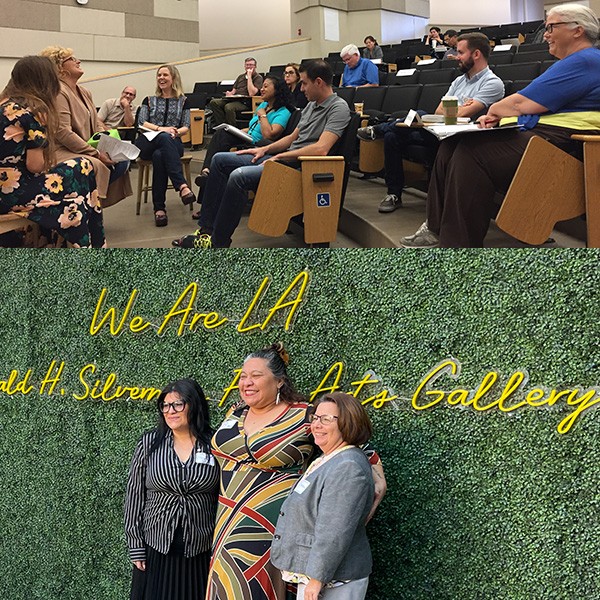Thinking about going online?
Online and hybrid courses have many advantages. Online environments offer excellent schedule flexibility; online courses are also an efficiency that can save you and your students time and gas. Such courses increase access to education. Turning a traditional course into a hybrid or online learning experience typically strengthens course structure and can improve pedagogy. Many faculty tell us that designing a blended or online course has improved their in-class teaching. Multiple studies, including 17 meta-analyses comparing online courses with face-to-face, on-campus learning, show that students can learn as well online as they do in traditional course environments.
The following page is for Cal State LA faculty who either want to teach online (including hybrid environments) or design (and teach) a hybrid/online course. If you are a faculty member interested in non-traditional courses, please first consult your Chair for departmental guidelines. Your department’s decision to move courses to an online environment is strictly the purview of faculty and the department.
Please note that teaching a course versus designing an online/hybrid course are two different processes. Each represent a different level of commitment. Faculty who have not taught online before will first want to take advantage of “Getting started with Canvas” and CETL teaching programming such as our “Active Learning” workshops, before embarking on a full course redesign.
Steps for developing and teaching a hybrid/blended or fully online course
Please note that according to the Cal State LA faculty handbook, a course's instruction modes refers to the amount of face-to-face versus online instruction in a given course. An online course is defined as "100% of the instruction of a course occurs online. This includes all class meetings, instructional materials, office hours and support, class activities, assignments, exams, and assessments." A hybrid course is defined as a course that blends "face-to-face instruction with more than 25% and less than 100% online instruction."
All Cal State LA courses offered as hybrid or fully online must first be approved for that mode of delivery on the appropriate original course proposal form.
To ensure an optimal learning experience for students, we ask that instructors follow these steps when planning to develop a fully online or hybrid course:
A fully online (or hybrid) course is not simply recording your lectures and posting them online. Online courses are not "lecture only" courses with interspersed online quizzes and exams. Creating a quality online course requires structure, planning, and a lot of activities so that students are practicing the skills and working with the content of your course. Do you already have at least one activity per week in your face-to-face course? Are there whole class discussions you conduct in your face-to-face course? Have you thought about what students will do inside and outside the classroom--aside from regular homework problems? Are you already using Canvas to collect assignments, promote discussions, and collaborate outside of class? If not, you may consider creating a technology-enhanced course first, that is, to beef up your use of technology in a face-to-face course before fully committing to an online course. You may also think about attending CETL's Active Learning Workshop to learn about activities you can do in your face-to-face and hybrid/online course.
Creating an online course is a big investment of time and talent. Take the survey
Make sure the course proposal form has been approved to offer the course as ONLINE or HYBRID. Both approved ONLINE and HYBRID courses for semesters are marked in GET and the schedule of classes as such.
Based on California Assembly Bill 386, passed in 2015, ALL ONLINE courses offered at Cal State LA will be available to students at any other CSU campus on the semester system. Other CSU students are able to go to http://www.csufullyonline.com to see what is available to them. Due to AB 386, there is nothing you can do to prevent other CSU students from taking your fully online courses. If there is room, other CSU students can take your fully online course. This means your online course should consider aspects of Universal Design for Learning (UDL) to ensure all students--including those requiring accommodations--will have equal opportunity to successfully complete your course.
Consult with your chair about offering a hybrid or fully online section of the course. Remember, hybrid courses will affect room scheduling. Make sure your Chair approves of this course. In order to maximize classroom utilization, department chairs should be aware of hybrid room scheduling too.
Are you effectively using Canvas? Canvas, the campus learning management system (LMS), has the tools to organize and make online course content interactive-- a key aspect of successful online environments. You should be leveraging Canvas activities (e.g., assignment, quiz, discussion, etc.) in your online course. If you do not use Canvas, take CETL's Getting Started with Canvas workshop ASAP.
In order to maximize use of the online environment, you need to be proficient with various online technology tools. Faculty teaching online or hybrid courses are encouraged to become a CETL Technology Enhanced Certificate Holder (T.E.C.H.). Faculty can earn the T.E.C.H. designation by completing at least six (6) CETL workshops. T.E.C.H. faculty can also request a Canvas template to help with the design of their F2F, hybrid, or online course(s). Visit CETL's website for more information on CETL workshops.
We strongly encourage instructors interested in teaching online to experience the students' perspective. There are a variety on fully on workshops for faculty to experience the student perspective: Quality Matters (QM), Online Learning Consortium (OLC) and/or Quality Learning and Teaching (QLT) training workshops can be taken. These are immersive experiences that help instructors appreciate what it’s like to be an online student. QM, OLC, and QLT are course development programs delivered online that will model an online experience for you and help you identify the design the elements necessary to deliver a quality course. Click here for more information on these initiatives.
Realistically estimate and commit to the hours you have to build the course--including how long it will take for you to learn how to do this. Are you already proficient with Canvas, Camtasia, Zoom, Turnitin, and/or textbook publisher resources, etc.? Do you already have multiple course activities in your course in addition to your lecture content? Set aside time each week to build the course. Creating a timeline is the most efficient way to map out your course. For example, if you have not used Canvas or do not use a lot of technology, you'll need to learn this before actually creating the course's online components.
Please note that in CETL's structured Hybrid Development Program, faculty spend over four (4) months in an intensive program to develop a hybrid course. This includes completing Quality Matters' Designing Your Blended Course (DYBC) workshop, attending several CETL design workshops, attending one-on-one instructional designer consultations, and completing and revising course maps/worksheets. This time also includes building a full Canvas course and addressing any accessibility issues (e.g., captioning of videos, making Word docs and PDFs accessible, etc.).
Faculty designing a course on their own timeframe should expect to take longer than this time.
How will your course be structured in Canvas? People learn through pattern-recognition. Create structure for what you will want students to learn in each module and follow it. A consistent online experience keeps students from missing deadlines, ignoring content, and helps them manage their time. CETL has created a flexible Canvas template usable for both online and hybrid courses. The Canvas template is available for CETL's T.E.C.H. faculty. CETL T.E.C.H.s can request the Canvas template here.
What quality assurance rubrics are you referencing while developing your course? Since fully online courses may be unfamiliar to some Cal State LA students, instructors need to go the extra step to help ensure their success in the online environment. There are several CSU and national quality assurance rubrics--that are research-based--that should be used when designing your hybrid or online course. By following these rubrics, you can help ensure that students will succeed in your online or hybrid course. A good checklist/rubric to review is the Online Learning Consortium's (OLC's) Quality Course Teaching & Instructional Practice Scorecard. This document provide tips, and best practices to consider when designing an online course. You can also view the Quality Matters (QM) rubric, another good resources. Additionally, the CSU used a Quality Learning and Teaching (QTL) rubric among the CSU campuses. Please contact CETL if you would like a hard copy of any of these rubrics.
Are you familiar with UDL? Since your course content is presented online, are you ensuring your videos are captioned; images have alt tags; Word docs or PowerPoint slides are accessible? From a UDL perspective, how are you ensuring your course provides multiple means of representation, engagement, and expression? At the very least, your course content should meet basic accessibility standards to ensure all students can succeed in your course.
Hybrid courses are not just in-class lectures with out-of-class homework. Hybrid courses are about developing challenging and engaging online learning activities that correspond with your face-to-face activities. What you do online should directly connect back to the course in a hybrid environment. Check out Cal State LA's e-copy of How to Design and Teach a Hybrid Course by Jay Caulfield. This is a great resource to get you started!

